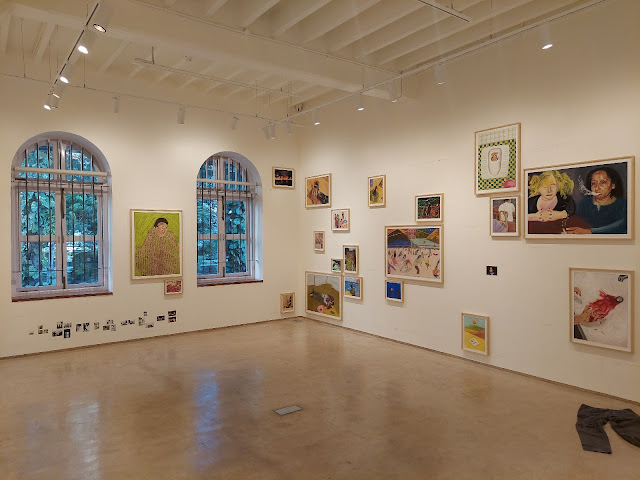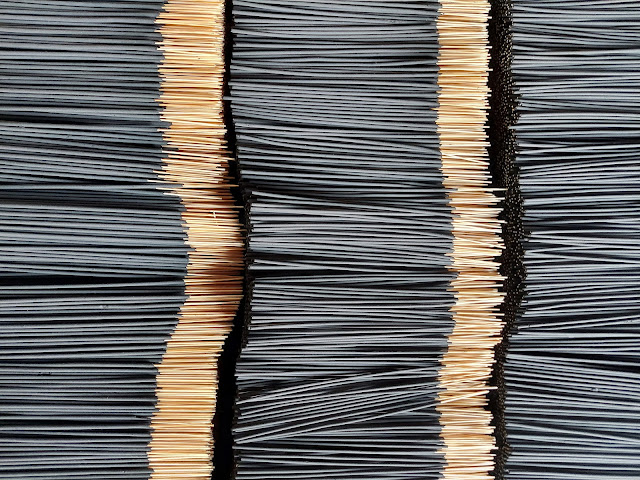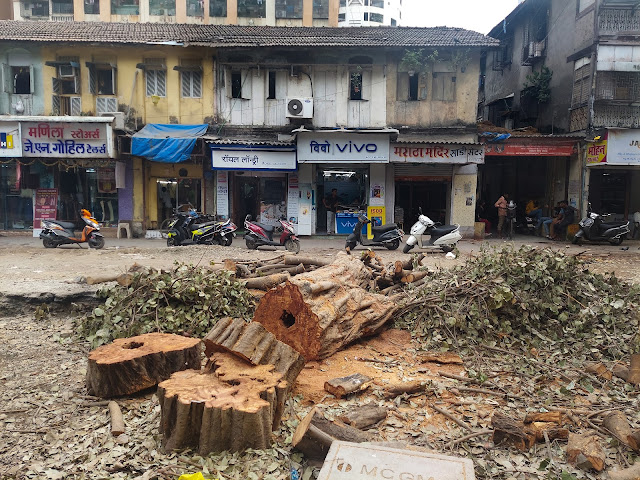Friday, February 02, 2024
Monday, January 08, 2024
On Art
"...Experiences that donot have words yet..."
All art perhaps tries to say something that conventional verbal or written language cannot capture, and vice versa. When something verbal can be expressed in art, it then becomes representation, or illustrative. This is the critique of representational art, perhaps. This, art that moves us is affecting us at a level slightly deeper than comprehensible. In the comprehension of that excess is where we push the boundaries of knowledge. The percentage of this excess may be very little, but to push that aspect is precisely the work of the artist. That is perhaps artistic practice, and what accounts to artistic "work". This work is not possible in the domain of representation, or total translation. For instance, if translation has to become art, then translation has to culturally push the limits of original text to become sustainable and critical for the present or future. This also doesn't mean that accurate representation of reality is not art. It doesn't mean that hyperrealism doesn't count as art. Here the context of time and space in which that art gets produced must be taken into account, for the disposition of that representative content on art may be quite different. To reinvent accuracy at different periods in history through the technology of its time, or in conversation with the technology of its time is then the content of art. This kind of churning allows perspectives to become referential and produce a search for relevance.
Sunday, January 07, 2024
The Qur'an at Chhota Imambara, Lucknow
This copy of hand written Qur'an is a marvellous example of not just calligraphy, but also the certain probable hierarchies of information. Notice the smaller texts of five types-
1. on top of the main text,
2. the one on the bottom of the main text
3. on the innermost border vertical (big and small)
4. the 45 degree clockwise diagonal in the middle and
5. the 45 degree anticlockwise diagonal on the outermost edge.
I need to check with a person who can read arabic to understand what form the subscripts and superscripts in this mammoth tome that has been managed purely manually.
The copy is on display at the Chhota Imambara in Lucknow and I am unsure of how old it must be, but it must be easily been 300 years old.
Saturday, January 06, 2024
Wednesday, December 20, 2023
The Perfumeries of Kannauj
These are technological sensoriums. A small town in Uttar Pradesh, an hour and a half away from Kanpur is Kannauj, which is known as the perfume capital of India. Here, attar has been manufactured through the harvest of a range of flowers and other fragrant plants though natural process since more than a millennium. The histories of this trade are speculative. While the techniques have certainly been developed much before, it was perhaps during the period of Mughal queen Nurjahan that the apparatus of distilleries was perfected further.
Sweet smelling petals or leaves of flowers or plants are introduced in large containers called degs and boiled with water. The degs have a thin long elbowed pipe made up of cane that pass the scented vapour into the bhapka - a receiver. The bhapka has a shallow layer of a base oil that soaks and settles the smell from the steam into itself, along with some essential extract. This extract contains some oil as well as water. While the water is let off, the essential oil remains to be used for application.
Each step of the process is detailed, and observed carefully. These assemblies are meticulous and need to be monitored with care. The pots, pipes, kilns, containers are measured to maintain their equation to the preserving scent as well as the operating body. As one enters the closed spaces of these perfume workshops, that once were in the open, each part feels phenomenologically animated. Most times, the building is shaped like a chimney - that contains the hearth in its belly, allowing the fumes to escape through its neck and mouth above. Almost a reverse wind tunnel, the perfumery space is mystified with light and air, smell and smoke.
The essential oils collected - the ruh of the flowers as they say - are poured into bottles made up of camel leather - called kuppis. These allow the slow seepage of excess water that may lay trapped in the final extract over a long period of time while keeping in the oil. The leather - as one of the last kuppi-makers Mustaqueem bhai tells us - needs to be procured by putting to death living camel for only the pores of that skin shall remain open. A deceased camel's skin may not serve the purpose. The skin is tanned and eventually shaped over an earthen mould which is removed once the bottle hardens. The skin is optimised for making kuppis of different sizes - nothing goes waste.
Speaking of waste, even the sludge of flower petals are kept for processing them into agarbattis, or incense sticks. These are kneaded with some amount of husk and clay and rolled into aroma sticks. Today these are available in different shapes, sizes and colours. Some other materials like saffron - that still have substantial smell - are passed on to sweet shops for further consumption. Some other left overs are used as fertilisers or compost, along with the ash of the firewood that fuels the deg-bhapkas. The excessive water is largely thrown away, or alternatively processed into flavoured waters for consumption or aroma diffusers. It is said that (and we also experienced) that the drains of Kannauj once smelled so fresh because all they primarily carried was rose water.
Surrounded by large farms of flowers and scenting shrubs, Kannauj is quiet container that produces perfume for not only India, but the entire world. Needless to mention that the principal economy of the town is production of a variety of perfumes, and the sellers are largely producing stock to be exported to international markets. They are hardly interested in retail - most shops are traditional gaddi style where significant deals are struck every week. These perfumes travel to places like Paris and Dubai where they are studied and enlarged in their volumes. These are then recomposed with different compounds, and mixed with various "bases" (like oil, alcohol, spirit, etc.) and created into the modern bottled perfumes that we buy today. There's a big industry of people quietly creating seductive smells for us, and remain as invisible as fragrance lay dissolved in the air.

Monday, November 27, 2023
Thane Kattey by Bhanvari Devi / Translation
Singer: Bhanvari Devi
Original Language: Marwari
साँवरियो घट माय रे, रमैयो घट माय (2)
In my heart is my beloved, as much as Lord Ram
थाने कठे, थाने कठे, थाने कठे, थाने कठे
Where are you, where do I find you?
साँवरियो घट माय रे, रमैयो घट माय (2)
In my heart is my beloved, as much as Lord Ram
थाने कठे, थाने कठे, थाने कठे, थाने कठे
Where are you, where do I find you?
थाने कठे ढूँढवा जाऊँ रे, साँवरियो घट माँ? ओ, जी, ओ
Where shall I go searching for you? O Dear that you are in my heart?
राम भी देख्या, लक्ष्मण देख्या, (2)
I have seen Ram, I have found Laxman,
Where shall I go searching for you? O Dear that you are in my heart?
राम भी देख्या, लक्ष्मण देख्या, (2)
I have seen Ram, I have found Laxman,
देखी सीता माई रे, ए-जी, देखी सीता माय रे
I also saw Mother Sita,
I also saw Mother Sita,
साँवरियो घट माय रे
He is inside my heart
थाने कठे , थाने कठे , थाने कठे , थाने कठे
Where do I look for you? Where after all?
He is inside my heart
थाने कठे , थाने कठे , थाने कठे , थाने कठे
Where do I look for you? Where after all?
थाने कठे वाळवा जाऊँ रे, साँवरियो घट माँ? ओ, जी, ओ
Where do I dig you out from? From inside my heart!
ब्रिम्हा देख्या, विष्णु देख्या, (2)
I have seen Lord Brahma, I have seen Lord Vishnu,
Where do I dig you out from? From inside my heart!
ब्रिम्हा देख्या, विष्णु देख्या, (2)
I have seen Lord Brahma, I have seen Lord Vishnu,
देखी सरुसती माई रे, देखी सरुसती माई रे
I have also seen Goddess Saraswati
I have also seen Goddess Saraswati
साँवरियो घट माय
You live inside my heart…
थाने कठे, थाने कठे , थाने कठे, थाने कठे
Where do I see you? Where?
You live inside my heart…
थाने कठे, थाने कठे , थाने कठे, थाने कठे
Where do I see you? Where?
थाने कठे वाळवा जाऊँ रे, साँवरियो घट माँ? ओ, जी, ओ
Where do I search you out from? My love is etched in my heart!
केरो देख्या, पाण्डु देख्या, (2)
I saw the Kauravas, I saw the Pandavas
Where do I search you out from? My love is etched in my heart!
केरो देख्या, पाण्डु देख्या, (2)
I saw the Kauravas, I saw the Pandavas
देखी दरुपद माई रे, ए-जी, देखी दरुपद माई रे
I have visited Mother Draupadi
I have visited Mother Draupadi
साँवरियो घट माय
My heart is filled with my beloved
My heart is filled with my beloved
थाने कठे, थाने कठे , थाने कठे, थाने कठे
Where do I see you though? How do I find you?
Where do I see you though? How do I find you?
थाने कठे वाळवा जाऊँ रे, साँवरियो घट माँ? ओ, जी, ओ
Where do I search you out from? You stay in my heart...
Where do I search you out from? You stay in my heart...
Friday, November 17, 2023
Sunday, November 12, 2023
Subscribe to:
Posts (Atom)













































